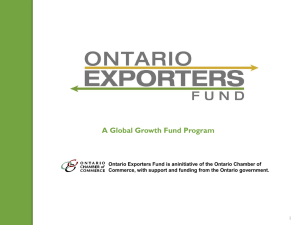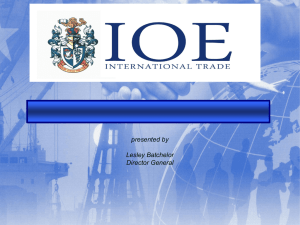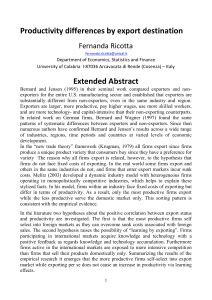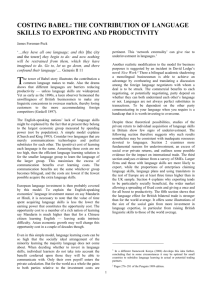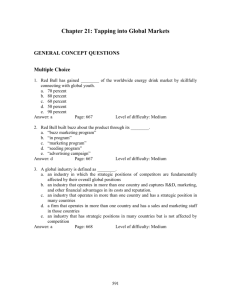Intangibles, export behavior and companies performance: the
advertisement
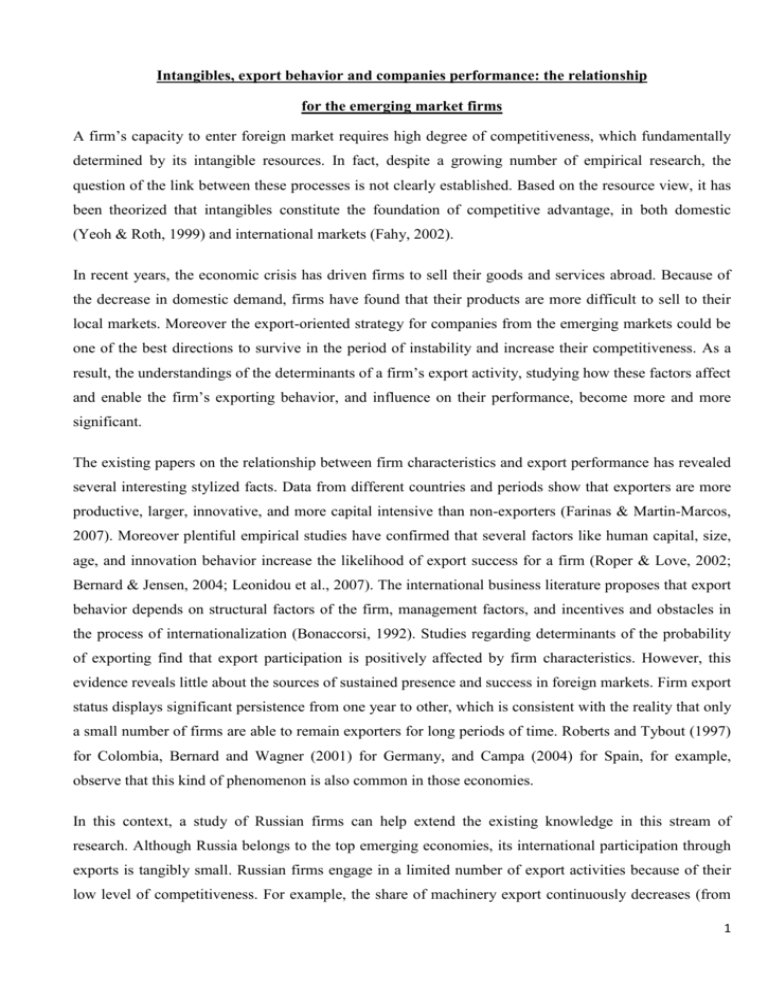
Intangibles, export behavior and companies performance: the relationship for the emerging market firms A firm’s capacity to enter foreign market requires high degree of competitiveness, which fundamentally determined by its intangible resources. In fact, despite a growing number of empirical research, the question of the link between these processes is not clearly established. Based on the resource view, it has been theorized that intangibles constitute the foundation of competitive advantage, in both domestic (Yeoh & Roth, 1999) and international markets (Fahy, 2002). In recent years, the economic crisis has driven firms to sell their goods and services abroad. Because of the decrease in domestic demand, firms have found that their products are more difficult to sell to their local markets. Moreover the export-oriented strategy for companies from the emerging markets could be one of the best directions to survive in the period of instability and increase their competitiveness. As a result, the understandings of the determinants of a firm’s export activity, studying how these factors affect and enable the firm’s exporting behavior, and influence on their performance, become more and more significant. The existing papers on the relationship between firm characteristics and export performance has revealed several interesting stylized facts. Data from different countries and periods show that exporters are more productive, larger, innovative, and more capital intensive than non-exporters (Farinas & Martin-Marcos, 2007). Moreover plentiful empirical studies have confirmed that several factors like human capital, size, age, and innovation behavior increase the likelihood of export success for a firm (Roper & Love, 2002; Bernard & Jensen, 2004; Leonidou et al., 2007). The international business literature proposes that export behavior depends on structural factors of the firm, management factors, and incentives and obstacles in the process of internationalization (Bonaccorsi, 1992). Studies regarding determinants of the probability of exporting find that export participation is positively affected by firm characteristics. However, this evidence reveals little about the sources of sustained presence and success in foreign markets. Firm export status displays significant persistence from one year to other, which is consistent with the reality that only a small number of firms are able to remain exporters for long periods of time. Roberts and Tybout (1997) for Colombia, Bernard and Wagner (2001) for Germany, and Campa (2004) for Spain, for example, observe that this kind of phenomenon is also common in those economies. In this context, a study of Russian firms can help extend the existing knowledge in this stream of research. Although Russia belongs to the top emerging economies, its international participation through exports is tangibly small. Russian firms engage in a limited number of export activities because of their low level of competitiveness. For example, the share of machinery export continuously decreases (from 1 23% in 2002 to 16% in 2012). On the other hand the macroeconomic data tell us that Russian companies export 30% of GDP in 2012 as well as it grows from one year to another (with a huge drop in 2008) during last 10 years. However, as HSE experts have observed, the share of firms with export less than 5% from turnover decreased twice (to 18%) from 2004 to 2008, and the companies share with export more than 10% from revenue expanded to 62% (from total number of export-oriented companies). Based on this evidence, the objective of this paper is to study why some manufacture firms are more successful than others in international markets. It should be noted that most of the previous research have focused mainly on the export decision and studied differences in firm characteristics between exporters and nonexporters, and conditioned their results only on surviving firms. We are particularly interested in investigating the determinants of the success in the exporting process by distinguishing between firms as non-exporters, sporadic exporters, and permanent exporters. We emphasize the following groups of determinants: environment factors, corporate governance factors, and firm characteristics. The key of them belong to intangible drivers. We would like to better recognize which economic factors explain the tendency for several companies to export permanently while others only export sporadically or not at all. As the outcome performance indicator following Olley and Pakes (1996) and Levinsohn and Petrin (2003a, 2003b), we compute a TFP measure by estimating a Cobb–Douglas production function. We obtained GMM estimates by using Arellano and Bond’s (1991) first-difference GMM estimator, where the instruments are all right-hand-side variables lagged three times or more on the sample of more than 200 public Russian companies within the manufacturing sector over a period of eleven years from 2004–2013 public Russian companies in the time period from 2004 to 2011. The database sample size is determined by the number of companies mentioned in the database Ruslana (Bureau van Dijk). Apart from financial data and intangibles proxies the dataset consists of information about each year export status of the company and major direction of the export. With regard to the self-selection effect, endogeneity implies that several firm features (for example, innovation behavior) may be affected exporting activities. According to Caldera (2010), the public support for the firm’s R&D expenditures may be a good instrument for measuring innovation because the public policies promoting R&D aim to increase the firms’ innovation activities and are unrelated to the firms’ exporting activities. Thus, these policies provide a good instrument for measuring the exogenous effect of innovation on exporting. In whole the results show a positive and significant link between innovation and export behavior. Our outcomes show that initial firm characteristics such as labor skills and technological innovation level are positively associated with exporting, but these same factors are unable to explain why some firms export permanently. In addition, our evidence suggests that previous export experience, multinational spillovers, 2 and an increase in performance positively contribute to the probability of becoming a permanent exporter. The model also reveals that industry effects are relevant. 3




